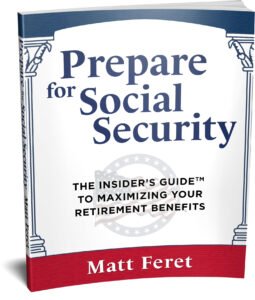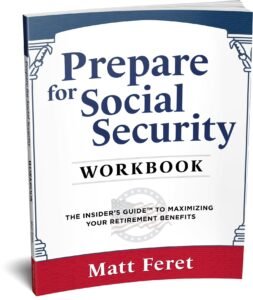#075
Share This:

In this episode of The Matt Feret Show I interview Sammy Wilson, a personal trainer and mobility coach. As a mobility coach, Sammy specializes in helping her clients mitigate the negative effects of a sedentary lifestyle by increasing their daily movement, mobility, and wellness. We discuss how sedentary jobs and lifestyles can impact physical and mental health and Sammy provides helpful suggestions and beginner steps listeners can take to increase strength, flexibility, movement, and overall wellness.
If you enjoyed this episode of The Matt Feret Show, you may also enjoy:
Unlocking Functional Medicine with CEO Paul Burgess
Medication, Fitness, Nutrition: Senior Health with Amy K. Wilson
Listen to the episode on Apple Podcasts, Spotify, Deezer, Podcast Addict, Stitcher, Google Podcasts, Amazon Music, Alexa Flash Briefing, iHeart, Acast or on your favorite podcast platform. You can watch the interview on YouTube here.
Brought to you by Prepare for Medicare – The Insider’s Guide book series. Sign up for the Prepare for Medicare Newsletter, an exclusive subscription-only newsletter that delivers the inside scoop to help you stay up-to-date with your Medicare insurance coverage, highlight Medicare news you can use, and reminders for important dates throughout the year. When you sign up, you’ll immediately gain access to seven FREE Medicare checklists.
Quotes:
“Whether it's doing some stretches, walk around the block, make everyone a drink, whatever it is. Just keep doing that at every interval. The ideal would be sort of moving all day, but the ideal is it's achievable for you.”
“There's no point in me being like, right, you need to go to the gym three hours a day, stretches, then go for a run. No one's going to be able to do that, right? If you've got 9-to-5 jobs, maybe you've got an hour commute, then you've got to have dinner. Maybe you've got kids to look after, maybe you've got an older person you've got to look after, whatever. Life gets busy and not everyone can fit that in. And that's why I always go on about it; it's so important just to move throughout the day.”
“I just love people getting involved, seeing progression, seeing people get happier in life. It does genuinely improve wellbeing, just moving and enjoying movement and enjoying how your body likes to be. That's the best thing about it. It's what your body wants to do. You're not trying hard to force anything, you're giving yourself what you naturally want.”
#075
Selected Link from the Episode:
Host’s Links:
All Things Medicare: prepareformedicare.com
Decoding Social Security: prepareforsocialsecurity.com
My Written Works on Amazon: www.amazon.com/stores/Matt-Feret/author/B09FM3L4WW
The Matt Feret Show YouTube: www.youtube.com/@themattferetshow
Network with me on LinkedIn: http://www.linkedin.com/in/mattferet
Follow me on X: twitter.com/feret_matt
See behind the scenes on Instagram: www.instagram.com/matt_feret/
Join our community on Facebook: www.facebook.com/themattferetshow/
Guest’s Links:
Sammy’s free Facebook group:
https://www.facebook.com/groups/activethrivingprofessionals/
Instagram: https://www.instagram.com/pocketptuk
Full Show Transcript:
Announcer:
This episode of The Matt Feret Show is brought to you by the Brickhouse Agency. Brickhouse is a boutique independent health insurance agency that focuses on finding the right Medicare coverage for folks across the country. Matt's wife, Niki, is the heart behind Brickhouse. She's great at making confusing things clear and is passionate about helping people find a Medicare insurance policy that suits their individual needs. To schedule a free one-on-one appointment with Niki or a member of her team, head on over to brickhouseagency.com or simply call (844-844-6565), and someone will help you schedule a phone call or a Zoom meeting. The consultation is free because the insurance companies pay Brickhouse, not you. There's never any pressure or obligation to enroll. Your clearer, simpler Medicare journey is just a call or click away. brickhouse agency.com. Not affiliated with or endorsed by the government or federal Medicare program. Contacting Brickhouse Agency LLC will direct you to a licensed insurance agent.
Introduction to Sammy Wilson with Matt Feret [1:09]
Matt Feret:
Hello everyone. This is Matt Feret, author of Prepare for Medicare and Prepare for Social Security Insider's, guidebooks, and online course training series. Welcome to another episode of The Matt Feret Show, where I interview insiders and experts to help light a path to successful living in midlife retirement and beyond. Sammy, welcome to the show.
Sammy Wilson:
Hi. Thank you for having me.
Matt Feret:
I'm glad you're here. So tell everybody what you do, how long you've been doing it, and how you help people.
Sammy Wilson:
Cool. So, I basically work as a movement and mobility coach, mostly online. How long? Oh, I've been a personal trainer for, must be coming on like eight, nine years now. But I've been focusing more on this kind of zone of it, the movement and mobility for the last year or so. So I'm kind of moving more into this area and I basically help people who spend a lot of their day kind of sat down or not moving a lot, quite still. Sometimes people in office jobs, that kind of thing. Sometimes people that drive a lot, sometimes people that just like a bit of safer time but helps people to just get up to move more. And by doing that they often tend to have a lot more energy to reduce kind of aches and pains. The ones that just kind of hang around and we just feel stiff and lethargic all the time, get rid of some of those and just feel more alive and more energetic and usually in a fun and kind of doable way. That's kind of how I like to help people.
Matt Feret:
Nice. Yeah, when I was prepping for this, I was reading all sorts of articles online and you get these statements that say sitting down is the equivalent of smoking a pack of cigarettes every week. I mean some ridiculous things, but by the same token, I mean sitting down all the time, I mean this is what I do all day. I mean, I'm at a computer probably a lot of folks or driving is it's active, but you're rolling your shoulders forward, you're holding your arms out, you're sitting stationary until you have to stop at a rest station or a gas station. What's so dangerous? What's so bad about sitting down all the time and the way we work and the way we live now?
The Problem with a Sedentary Lifestyle with Sammy Wilson [3:00]
Sammy Wilson:
I'll say bad. I mean, it's a weird thing. The things that stand out, that you mentioned, is the equivalent of smoking cigarettes. Obviously it's bad in a very different way, it's not going to your lungs, that kind of thing. But there are so many things. So we have load of people having chronic pains, that kind of thing, just aches and pains throughout their lives, feeling tired and lethargic and even things such as certain sort of cardiovascular diseases, chronic diseases, that kind of thing. You can be so much more at risk of developing those kinds of things if you do spend a lot of time sat down, just your energy and the way you feel on a daily basis. And what a lot of people don't realize is that the amount of time you actually spend sat down.
So, if you've got a traditional office job, you just kind of think of the hours that you are there. But yeah, like you said, driving as well. So if you count the hour, sat in your car, driving there, then you get there, sit there while you are on your laptop, usually in kind of a hunched over shoulder position, often spend your lunch breaks, sat down watching TV, sit down more in the office, sit down for the drive home, get home, sit down again. It literally is a lot of the day and what a lot of people don't realize, people that even do maybe have a sport or an exercise they do in the evening. So after work you might go to the gym and spend an hour in the gym. That's often not enough to compensate for the effects and the actual risk it's putting at you of certain all those diseases and feeling lethargic and aches and pains, that kind of thing. It's not enough to compensate for it. So yeah, sitting down can be a lot worse than people give it credit for really.
Matt Feret:
And you can take a lot more of your day than you really even realize you were ticking off that list. And I was shooting back to a time where I was commuting, not that long ago, where I was commuting in via car into the city and if I left at the wrong time of the morning, it was an hour and a half in the car. And then you get to the car garage, and you get on the elevator and then you go to your desk with a chair and then you did it all again at night. Yeah, that's a lot of sit time. Is there some sort of ratio that some should think of or is there some sort of timeframe of get up? I mean, Apple Watch, if I sit around too much, it'll say get up and it'll give me rewards. Is there some sort of magic number to if you're sitting or seated to get up and do something?
How to Mitigate the Harm of a Sedentary Lifestyle [5:30]
Sammy Wilson:
I don’t know there's a magic number as such, but the way I see it, it's manageable for you. So, when I work with people that spend loads of time sitting down and just, they can't get out of it, right, because it's your job. You can't just not do it. You have to sit down all day to do your work and you have to commute in, but it's just setting what's manageable for you. So, you've mentioned the sort of Apple Watches or Smart Watches are really good at this because they have, my one anyway, does this thing where every hour it wants you to get up and move about a bit. But even if you don't have a watch, you can sort of set that up yourself. So, a little tip that I give out quite a lot is to set, not an alarm, I think it's called a timer on your phone.
And that timer is going to go off whatever you think is manageable. For some people you might think, oh, I can't afford that much time on the day I'm really busy or whatever, two hours is the best I can do. Or some people might be able to do half an hour, but whatever you think you can manage, just set your timer to go off at those intervals and every time your timer goes off, you just get up and you just do something. Whether it's doing some stretches, walk around the block, make everyone a drink, whatever it is. And yeah, just keep doing that at every interval. So yeah, I don't think there's, well the ideal would be sort of moving all day, but the ideal is it's achievable for you, I'd say.
Matt Feret:
Yeah. So what should I do when I'm getting up once an hour or once as often as I can? Do I need to drop to the ground and do 20 pushups? Do I need to do the lunges during lunch or is it just a walk? Is it a stretch? What do I do?
Sammy Wilson:
If you are literally just starting out and you are someone that just sits down all day, anything is better than nothing. So it is what's suitable for you. So you can literally just get up, do a walk around the block, come back to your seat and sit back down. Or I briefly mentioned a really good one is you can just offer everyone a drink, offer everyone a coffee, go and make them come back and that's got you moving. You can have more water yourself. That's always a good thing. Yeah, like you said, an ideal thing would be it depends on your office and how silly you can be, what you can get away with. In my office I used to work in, I used to literally, I had a yoga mat by my desk and I had quite a casual office, it was fine, but I could whip out my yoga mat and do some stretches and some exercises, but completely understandable. In some offices you can't do that. So really kind of assess your vibe, but sometimes you can get other people joining in and then you don't feel as silly if you convince your coworkers or let's do this thing together and then you don't feel like an idiot. Right? Yeah. There's even stuff you can do at your desk if you rarely can't get up.
Matt Feret:
What kind of things at my desk?
Sammy Wilson:
So, you can do stretches. For example, if you're just sat there, a really simple one is you can just move your neck around. So you can do tilts little circles of your head, you can do shoulder rolls like forwards backwards. That one feels really good actually because when you're sat at a desk, the muscles on the front of your shoulders are usually the ones that get really weak and tight because of this hunch over position. So hands forward on your keyboard, you get really sort of weak here. And then the ones on the back of your shoulders, they also get weak because they're not doing anything, they're just sort of hunching forwards. So doing something like big shoulder rolls, just make them as big as you can. Those are really, really good for releasing your shoulders. We can also twist, so we can use the chair to sort of do a twist around.
One I really like is because when we sat down on a chat, basically our butts, our glute muscles, get really relaxed and lazy because they're just in that sort of seat position. So one you can do is if you bring one leg over so you sort of cross your anchor over your other knee, you can have a bit of a butt stretch there. Basically you can roll your anchor all around, that feels good. But yeah, if you get creative, there's so much you can do without actually getting up off your chair, which is really cool.
How to Improve Posture in a Sedentary Lifestyle [9:19]
Matt Feret:
Can you talk about posture at all? Because I kind of half mentioned this earlier, but we spend so much time sitting and typing and we've all read about ergonomics and then you're supposed to buy the fancy chair and the fancy wrist guard for your mouse. You're supposed to pretend like you're playing the piano and roll your wrists up. You're not supposed to leave them flat and all these things that just you forget or you get lazy and don't do. But then if we're driving, it's the same motion. You're rolling your shoulders forward, you're sitting on your rear, it's all this repetitive motion piece. Is there something it feels like most of the, let's say the modern world, I'm not sure. Well anyway, in the United States, most people who have office or even anything, their shoulders are rolled forward. I mean I've seen people hunched up and their shoulders are rolled and you're like, no, your correct posture is supposed to be up a little bit. It's really hard to do when you spend most of your time with your arms forward, peering at something, peering through the windshield, peering at a computer screen. How cognizant do we need to be around the way we're sitting? Or do you have to switch it up? Yeah, do we switch it up? What do we do?
Sammy Wilson:
I think we do. So I've always said that any posture, there's not one perfect posture. So if I say sit with good posture, a lot of people go really upright and they sort of know a bit of a soldier, that kind of thing, which is fine, but ideally our bodies do want to be moving throughout the day. So we don't just want to have one perfect posture and just sit in that all day, get so stiff and tight. Our muscles and our joints don't like to just be dead still. So yeah, like you said, we want to be moving throughout the day, but as you sort of touched on, there are certain guidelines that can help. So if you are going to be sat in your desk for a long time, there are certain things that have certain things like having a good chair that is going to support you.
So, you can get one with lumbar support and that can help. So, if you've got a generic, I don’t know, wooden chair or something that doesn't have any support, you end up leaning forward a lot more because it's not comfortable to sit on the way the chair is. If you've got one that gives you that bit of back support, it's a lot more encouraging for you to lean back into it and help the chair support you. If you don't have one of those chairs or maybe your office isn't willing to invest in a fancy chair for you, you can even buy, you can get them from Amazon of 10 quid, I think. Sorry, dollars.
Matt Feret:
That's fine. Someone will do the conversion online.
Sammy Wilson:
But you can get them that you literally just put on your chair and it's really good for support in your back. And things like you mentioned as well, like wrist supports, even the way you set up your desk. So ideally you can probably see that mine's not exactly perfect here, but ideally your eye level should be going exactly to the middle of your screen so that you're not having to bend your neck forward. If you are looking straight ahead, that's a lot better for your neck. Everything should be within a good reachable distance. Ideally your feet flat on the floor. So if you're having to go on your tiptoes, you might need to get a footrest. Trying not to sit for too long with one leg crossed over if you are going to do that, make sure you change often. But yeah, just little things like that, even though we're not even talking about moving now, they can make such a difference to things like aches and pains and how you feel throughout the day just by sitting well with good posture.
Finding the Balance Between Posture, Exercise, and Rest [12:42]
Matt Feret:
Yeah, you've mentioned aches and pains a lot, and I guess my brain goes towards two things. If I sit too long, or I hunch over too long, I've got aches and pains normally in my back. Normally when I've gone to a chiropractor with back issues or even a massage therapist, there's this band that I don't remember the name of it, but it's between my shoulder that's always super tight and why is that always tight? And they're like, it's tight on everyone. And the reason is because everyone sits and everyone puts their arms forwards and rolls them. But there's also if I'm working out or doing squats or anything else, that's aches and pains too. What's the right balance? What's the right balance to get that upper body and that back, I guess, tuned up? You said earlier if you're working out an hour at night, that's not enough. So what's the kind of the right combo prescription for someone who's desk bound or spends a lot of time seated?
Sammy Wilson:
Yeah, I get what you mean. It can almost feel the same kind of with the aches and pains that, like you say, if you've been sitting at desk all day, you've got an achy back and you're like, oh. Whereas it's almost a different type of pain. So, if you've been at the gym, we have, what sort of in the fitness interview are called DOMS, which is where your muscles are. So basically, when you work out really hard and do sort strength training, you actually get little micro-tears in your muscles. So that's what that pain is. It's just them as they repair and get stronger. So it's kind of a different thing that's going in your body to the pains we get when we've just been sat down all day. And that's more of a lethargic kind of creaky pain. And those are the ones that if sort of left untreated. And a lot of people when they do get those kind of aches and pains that, oh my back's a bit sore today, oh I need to have a day off the gym, I need to rest. And that's when it can lead into a really chronic long-term issue because those kinds of aches and pains that are just from doing nothing, it's not going to help by doing nothing to try and help it, if that makes sense. They need to move.
Matt Feret:
Yeah, it's kind of the old, if you've worked out and you've got a lot of lactic acid in your muscles and they're painful, go do another workout.
Sammy Wilson:
That does help. And one of the things I recommend in terms of doing a workout is getting a really healthy balance of resistance. Sorry, resistance training. Cardiovascular training and mobility training and mobility is the one that so many people forget or neglect. A lot of people I know know that they should be doing it, but it is the boring one, so we don't do it. And that's kind of why you are not necessarily just sat in a stretch, not just stretching out but working with your muscles so that it supports them as they're developing and you're seeing your other training. But doing a combination, all three can really reduce those aches and pains you get the muscle soreness you get after doing your training and it can reduce the risk of injuries because it helps you repair those muscles in the right way and balance them so that it kind of counteracts, it helps more counteract all those effects of sitting at the office.
But what else did you ask? How do you get the right amount? And again, it really is, it's individual because it's what you can fit into your life. So there's no point in me being here and being like, right, you need to go to the gym three hours a day, send your stretches, then go for a run. No one's going to be able to do that, right? If you've got 9-to-5 jobs, maybe you've got an hour commute that's already eight or six, then you've got to have dinner. Maybe you've got kids, you've got to look after, maybe you've got an older person, you've got to look after, whatever. But life gets busy and not everyone can fit that in. And that's why I always go on about it. It's so important just to move throughout the day. A lot of what I teach is really short and to the point workouts. So all the mobility sessions I run for my clients, they're all 15, 20 minutes long. So you don't need to set aside two hours to go to the gym, including driving, showering, all that. It's just 15 minutes that you can literally do in your lunch break or as soon as you get home from work in the morning whenever. And I think that's the best way to make it achievable for busy people. Just keep them really short and to the point.
Matt Feret:
So besides going on, and I want to hear about what you're doing online too, but besides going on your channels and your opportunities there to connect with you, is there a magical exercise for people who are sitting most of the time I noticed that you were swimmer, I've got to think swimming does cardio and resistance training in the water. I've heard rowing, if you poke around a little bit doing those row machines and it works out every muscle in your body and it's cardio and it's more efficient or burns more calories than running or is it just running weightlifting? The whole thing is there. If I've only got a certain amount of time during the day, is there a magical exercise or two that can kill two birds with one stone?
Sammy Wilson:
Well, the way I see it, I actually would done always say it's the opposite to one magical exercise. So a lot of people ask that, that's such a common question of only got time to do one. What's the best one I can do? And my answer would be a different one every day. So whatever exercise you do, even so example rowing you say is really, really good for people that work at a desk. You are strengthening those muscles on the back of your shoulders that get really weak from sitting at a desk. But if all you ever do is row, you're going to end up with a load of imbalances. So you're going to have certain muscles that are really strong that support the rowing and certain muscles that are really weak because you're completely neglecting them. And I always like to think of your body as a whole unit, right?
It's like a machine that needs every lower part to function properly, and you need to work on every little bit of that, right? If you neglect certain bits and only pick on one muscle, I don't think there's any exercise, that I know of anyway, that works every muscle equally. So you're going to need to do a mixture to make sure you're all balanced, everything's working. So yeah, you still don't need a load of time. Even if you've only got time to do your one exercise a day, just make it a different exercise every day. And one of the really important things as well, this triggered me because I remember because you said, oh is it running? One of the things I always teach is that make sure it's something you enjoy. So for me, for example, I absolutely hate running. So if someone was to tell me the best thing for you to do is go out for a jog every day, which for a lot of people they like doing that because it's out in nature. It's like an easy thing to do. You don't need any equipment, great, if you enjoy it, do that. But if that was me, I would probably do it for about three days and then give up and never come back to it ever again. So it makes sure it's something that you genuinely enjoy and that'll make it so much more easy to maintain it and kind of keep doing it and it not feel like a chore sort of thing, if that makes sense.
How to Increase Movement in Challenging Circumstances [19:35]
Matt Feret:
Oh, it makes all the sense in the world to me, I can't stand running if I go running, I have to have my favorite playlist loudly in my ears. It has to be perfect weather. I have to have, I don't know, a beautiful view. And I mean it's just the most boring thing in the world and I know that people love it, but I mean I would rather swim back and forth and do laps that is less boring to me than running outside. I don't know why. It's just if I'm running, I have to be playing a sport. I'll play soccer or I'll play- I have to be doing something other than running. Running has to be a sideshow to whatever it is I'm doing. But I get it. Alright, let's go to folks who are sitting not by choice, who are either disabled or that are weight that it makes it uncomfortable or they haven't worked out in a very long time. How do we start? Is it that I've got to go- I'm assuming it's not that I just got to go sign up for a gym and go get a personal trainer and go crazy? Are there little baby steps to just starting from zero?
Sammy Wilson:
Yeah, I'd always start with baby steps. So if wherever you are, whether like you said, if you are someone that's disabled or anyone never start by just going all in and just being like, right, I'm going to January. People in the gym that have done nothing throughout the whole of winter and then they're like, right, I'm going to smash the gym. I'm going every day for two hours. And you know what, they're all gone by February, aren't they? So it never works to go all in and just try and smash it because either you'll get an injury, you'll get bored of it, you'll just be like, I'm done with this, it's too hard, whatever. So yeah, always as you say, baby steps, whatever your situation. But yeah, the first thing you could do if you are sort of stuck in a seater position that you can't get up and move, just do stuff in the seater position.
So, there's so many exercises you can do. That's something I teach as well, but you can find it even on YouTube, just do a little search for a 20 minute workout and there'll be something, there's so much free stuff out there on the internet in terms of workout routines and obviously as you progress you do need stuff more personalized. But if you're just starting out and you're just wanting to move, there's so much stuff out there that you can use from a chair. There's loads of stuff you could do with lightweights in your hands. You can use resistance bands, and if you don't have any of those equipment, you don't have any weights or bands, you can just use household objects like just a can of beans for example, or a handbag full of weights. You can really adapt it so much and just get started. And like you said, if you sort of want to progress more, go to the gym, get a personal trainer, anything like that, hopefully if you've got a decent trainer, they won't throw you straight in anyway. They'd kind of go through the baby steps. But yeah, just do what's manageable and progress yourself slowly and make it manageable.
Matt Feret:
I'm thinking of members of my own family at one point that were older and maybe had some medical conditions and spent a lot of time sitting in front of the TV, which is sad, but that's reality for a lot. So if I've got a mom, dad, grandma, grandpa, or a family member that that's their life right now, how do you think, what should I be encouraging? What should I be talking to them about or noticing in terms of the amount of seat time got, even if they've had a stroke or something along those lines. It's still important, I'm assuming, no matter your age to try to do some sort of mobility even if it's harder.
Sammy Wilson:
Yeah, a hundred percent. So like you say, for those kind of people that just end up spending a lot of the day on the sofa watching TV and that kind of thing, it can be the first thing that's important to understand. It's really hard to get out of that habit. So the more you sit down, and you might feel this if you work in an office or if you ask someone that sits down a lot, the more you sit down, the less you want to move. And that's kind of on a physical level and a psychological level. So the more you sit down, the tighter your muscles get your joints or seize up, think of your joints sort like a door. If you keep it moving, it's really well oiled. It releases this synovial fluid, which is kind of the thing that lubricates your joints.
If you sit still and don't move them very much, you actually get less of that lubricant sort of fluid in your joints. So they do actually seize up and it's harder to move them. You get lethargic, so you feel like you have less energy to move everything sort of physiologically in your body. The more you sit still, the more it's just like I really need to stay that still it's going to be a big effort to move. And then psychologically as well, the more you sit still, the more your brain almost gets, you can almost lead to things like depression and low mood, that kind of thing because your brain just doesn't work well on no activity. It wants your body to move, it wants to be active. The more you move, the more oxygenated to blood you have pumping on your body helps you release, feel good, endorphins, all that kind of thing.
So if you've got someone that's been spending a lot of time sat down, just understanding that to start is going to be really hard on their body and their brain. So maybe just make something small and easy to start with. Maybe even have a little small fun exercise routine. So like a 10 minute, oh, let's do this together kind of thing. And definitely make sure it's something easy if they've been sat down for a long time. But yeah, that's a great idea. I think just starting doing something with them together, make it fun, make it like a social occasion and then maybe just try and gradually build that up every day to doing a little bit more. Maybe then advance it to 15 minutes or maybe do it twice a day. Just gradually kind of increase it.
Sammy Wilson’s Online Presence and Free Groups [25:26]
Matt Feret:
Yep. So tell me about what you're doing online. I would love to hear how are you reaching people?
Sammy Wilson:
So I've basically, it's a group, it's called the Movement Club, and it's for people that aren't elite athletes or don't have any massive goals. They don’t want to get massive in the gym or anything like that. There's people, everyday people that just want to move more to feel healthier, feel more energized, and just have a bit more life to them. And we do well, we progress really gradually, but we basically do a couple of resistance training sessions a week that are really short and manageable. And then we do mobility sessions. So we just move, we feel good, we help each other, they like tips, advice, we have little challenges and it's just a really fun and doable way of getting people moving. And I just love people getting involved, seeing progression, seeing people get happier in life I guess. And it does genuinely improve wellbeing, just moving and enjoying movement and enjoying how your body likes to be.
I guess that's the best thing about it. It's what your body wants to do. You're not trying hard to force anything, you're giving yourself what you naturally want. So yeah, I have that. And also if you're wanting to just join in, but not ready to join the Movement Club yet. It is a free Facebook group actually, it's called Active Thriving Professionals, and that's for people, I just give it out a load of free advice, free tips on there, and it's a nice little community, so we all help each other out, free to ask questions on there, give each other tips. So yeah, anyone's free to join that.
Matt Feret:
What's the Facebook group called? It's a Facebook group.
Sammy Wilson:
Yeah, it's free to join. It's called Active Thriving Professionals.
Matt Feret:
And then I saw TikTok on there.
Sammy Wilson:
Yes, I do a decent fun TikTok.
Matt Feret:
I am not, I'm not on the TikTok’s I get sent stuff by my kids and I refuse to download the app. It's one more thing I can't do, but I know it's super popular. What do you do on there?
Sammy Wilson:
It did take me a while. I feel like I'm too old to get TikTok. It took me a while to get there, but I know it's a bit of fun and I just share a little tips. For example, I might do one that's like three of the best exercises for your shoulders or three ways to stretch out your hips. So if you're just wanting really fast to the point, little tips and tricks, then yeah, give me a follow on TikTok. I'm on there as PocketPTUK. So yeah, feel free to join in.
Matt Feret:
I mentioned earlier, but you didn't say it, but I do want to hear about your swimming.
Sammy Wilson:
Yeah? So my background in swimming, so I kind of grew up, it's actually synchronized swimming. Do you know what that is?
Matt Feret:
I do.
Sammy Wilson:
Oh, you do? It is now called artistic swimming if you are sort of more of a modern person. But yeah, I grew up in that and I ended up, I think when I was 17 I got into the British senior team. So that was really fun. I got to travel the world with them and stuff completed at World Championships, which was really cool. And it was, to be honest, the most memorable thing about it was just how hard it was. We used to train, I think on average it was like 45 to 50 hours a week of training we would do. And that'd be a mixture of land and in the pool. But yeah, it's such a unique sport, isn't it? There's not many people that have done that or tried it. I think it's harder than people think. If you're someone that thinks we just sort of stood on the floor or making pretty patterns or waving your arms in the air, give it a search, very difficult.
Matt Feret:
No anything in a pool, yeah, I remember thinking, well water polo sure looks fun. Oh my gosh, how hard that is. Just keeping your head above the water with one arm while you've got a ball is difficult. Yeah, I can't imagine how synchronized swimming or artistic swimming is. So, 40 some odd hours a week of training to get to a point where we're all looking at a thing of beauty from a wide shot above.
Sammy Wilson:
Literally. And it has advanced and back in the day it used to be floating, making pretty patterns, all that kind of thing. And now I guess the way to describe, it's a lot more like aggressive. It is really fast paced and it's all about getting as high out as you can, throwing each other. It's got very acrobatic. Yeah, it is a lot of fun. And I do miss it some days. I sometimes still do it. I do it for an agency. It's like a performance thing. But yeah, it is a lot of fun. If you've never tried it, give it a go. And it is obviously anything in the water of the regular swimming water polo synchro if you wanted to try that. It is all low impact activity. So even though it's really intense and it works so hard on your muscles, your cardiovascular system, all that, it's low impact. So if you do have any joint tissues or anything like that, it's a really good way of getting into exercise, doing some kind of aquatic sport.
Matt Feret:
Yeah, that's the old, I think the non-competitive piece out here is water aerobics, right?
Sammy Wilson:
Yeah. Okay. Yeah, that's the one they do in gyms and fitness clubs and stuff, isn't it? But that looks good.
Matt Feret:
I haven't either. I just know that there might be a member of my family that does, which is good. Which is fun, right?
Sammy Wilson:
Good for them.
Matt Feret:
I don't know that I could do it. I'd feel too much like the 1980s VHS tapes of, I don’t know, version just in the water.
Sammy Wilson:
They tend to be quite woman based as well, don't they?
Matt Feret:
Yeah, true. Hey, listen, this has been fascinating. It's been a very specific topic, right? This is seated people, professionals, but people who are seated a bunch of time. I mean you were talking earlier and I'm like, boy, how much do I sit down a day? I've never even measured it. I know it's a lot, but it's probably more than, I think it's a very specific topic. And what questions did I not ask about it that I should have?
How Fitness Can Improve Mental Health [31:30]
Sammy Wilson:
Oh, is there anything we haven't discussed? Oh, I mean we haven't really touched how it can also affect things like mental health. Is that worth having a chat about?
Matt Feret:
Absolutely. That's why I asked that question. Yeah, go for it.
Sammy Wilson:
So really it can affect it. It can have such a big effect on how it makes you feel physically, how it can help you avoid injuries if you do have any falls, anything like that. It can help you come back faster, but also has such a big effect on your brain and your mental wellbeing. So without even telling you any of the science behind it, if you just think about the last time you did exercise or had a good workout, I can almost, unless something went bad, and I could almost guarantee that you felt really good after it. And even if you don't enjoy the exercise, even if, for example, I've been for a run, you hate it when you're doing it sometimes, but after you've done it even more, if you do an exercise that you actually enjoy, you feel so good.
And that's just the thing. If you feel that way, it's real. But the way that works is it when your brain, it gets more like oxygenated blood pumping to it, it releases feel good endorphins, so it literally makes you feel good. It can reduce stress hormones as well. So if you are someone that's spending loads of time at a desk, if you are sort of a really busy office person for example, you are really tied down in your work, really stressed out that you've got so much to do, getting up and having a little movement break, even if you're not talking about a full on exercise session here, even if there's what we talked about earlier where you're just getting up and walking around, it can reduce that stress and it can also actually make
Having that little burst of energy. And what I always say is that when you feel most, you are not able to get up and do something. So either you're feeling really down, you're in a really low mood, you just want to lie in bed, or sort of the opposite, well not the opposite, but another situation where you are sat in an office and you feel so bogged down with work that you don't have time to get up and move, that's probably when you most need it. So really trying to almost use little tips, even if it's like five minutes, just get up and do something, make it small, make it manageable, and that'll make a big difference to how you feel.
Matt Feret:
Awesome. Sammy, thanks very much for being on the show and sharing all this with us.
Sammy Wilson:
Oh, thank you so much for having me. It's been fun.
Matt Feret:
The Matt Feret Show related content, publications, and MF Media LLC is in no way associated, endorsed, or authorized by any governmental agency, including the Social Security Administration, the Department of Health and Human Services, or the Centers for Medicare and Medicaid Services. The Matt Feret Show is in no way associated with authorized, approved, endorsed, nor in any way affiliated with any company, trademark names or other marks mentioned or referenced in or on The Matt Feret Show. Any such mention is for purpose of reference only. Any advice generalized statistics or opinions expressed are strictly those of the host guests of The Matt Feret Show. Although every effort has been made to ensure the contents of The Matt Feret Show and related content are correct and complete flaws and regulations change quickly and often. The ideas and opinions expressed on The Matt Feret Show aren't meant to replace the sage advice of healthcare, insurance, financial planning, accounting, or legal professionals.
You are responsible for your financial decisions. It is your sole responsibility to independently evaluate the accuracy, correctness, or completeness of the content services and products of and associated with The Matt Feret Show, MF Media LLC, and any related content and publications. The thoughts and opinions expressed on The Matt Feret Show are those of the host and The Matt Feret Show guests only and are not the thoughts and opinions of any current or former employer of the host or guests of The Matt Feret Show. Nor is The Matt Feret Show made by on behalf of or endorsed or approved by any current or former employer of the host or guests of The Matt Feret Show.















